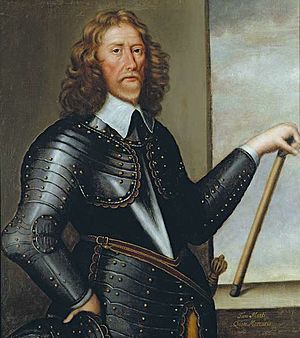Sir Thomas Gascoigne, 2nd Baronet facts for kids
Sir Thomas Gascoigne, 2nd Baronet (1596–1686) was an important English nobleman. He was a member of the well-known Gascoigne family. Sir Thomas is remembered for surviving a big event called the Popish Plot. This event was also known as "the Barnbow Plot" in his local area.
Contents
Who Was Sir Thomas Gascoigne?
Sir Thomas was the oldest son of Sir John Gascoigne, 1st Baronet. His family lived at Barnbow and Parlington Hall in Yorkshire. They were a very religious Roman Catholic family. Sir John himself had become Catholic. Thomas's mother was Anne Ingelby.
His Family's Religious Life
Many of Thomas's younger brothers and sisters chose to live religious lives. This was common for Catholic families in Yorkshire at that time. His sister Anne married George Thwing. Their son, Thomas Thwing, later became a martyr. Another sister, Catherine Gascoigne, became an abbess (a leader of nuns) in Cambrai. His sister Justina was a prioress (another type of nun leader) in Paris. Three of his sons also became religious leaders. One son, John (1598–1681), became the abbot of the Benedictines at Lamspringe Abbey.
Life as a Baronet
Sir Thomas became a Baronet in 1637. He spent most of his life quietly looking after his family's lands. He also managed a successful colliery, which was a coal mine. During the Popish Plot, people accused him of bad things. But his main defense was that he almost never left home. He had not been to London for many years. This showed he could not have been part of a big plan. He also generously supported the Franciscan religious order. They had a house near Thirsk.
The Popish Plot and Sir Thomas
The Popish Plot was a time of great fear in England. Many people believed there was a Catholic plan to harm King Charles II. In Yorkshire, this event was often called the Barnbow Plot. This name came from the Gascoigne family's estate.
Accusations Against Sir Thomas
During this time, two former employees, Bolron and Mowbray, accused Sir Thomas. They claimed he was part of a plan to kill King Charles II. However, Sir Thomas was found not guilty. After his trial, he moved to Germany to live out his final years.
Why the Accusations Were Unlikely
It was hard to believe these accusations against Sir Thomas. He was nearly 85 years old, deaf, and almost blind. He rarely visited London. In fact, he had barely left his own home for 30 years. This made it very unlikely he could be involved in a big conspiracy.
His Trial and Acquittal
Sir Thomas was ordered to have his trial in London. But he wisely asked to be tried by a jury from Yorkshire. This delay gave him time to get ready for his defense. The judges agreed that a local jury would know the witnesses better. This helped them decide who was telling the truth.
By spring 1680, the fear from the Popish Plot was fading. The judges at Gascoigne's trial were fair. They told the jury that Bolron and Mowbray might not be reliable witnesses. Many of Sir Thomas's Protestant neighbors respected him. Several even traveled to London to speak in his favor.
The court also heard about the Franciscan house at Mount Grace, Thirsk. Sir Thomas supported this house. They also talked about a convent (a place for nuns) at Dolebank. Sir Thomas's daughter, Anne Tempest, had started this convent. The judges did not see supporting Catholic places as a crime. Even though it was technically against the law to give money to Catholic religious houses, the King often ignored it. The monastery at Mount Grace even survived the Plot.
Unlike earlier trials, the judges did not push for a guilty verdict. The jury easily found Sir Thomas not guilty. People criticized the jury at first. But public opinion slowly changed to support the Catholic community. Most people accused with Sir Thomas were also found not guilty. They were supposedly part of a secret agreement called "the Bloody Oath of Secrecy."
The Fate of His Nephew
However, Sir Thomas's nephew, a priest named Thomas Thwing, was also accused. The prosecution claimed a "list of conspirators" was real. But this list was actually people who had given money to support the new convent at Dolebank. Three of Thwing's sisters were nuns there. Because he was a priest, Thwing was the only one found guilty. The King first offered him a pardon. But because of pressure from Parliament, Thwing was executed on October 23, 1680. He was executed for being part of a conspiracy, even though no other conspirators were found guilty.
Later Life and Family
After being found not guilty, Sir Thomas left England for good. He settled in Germany. He passed away in 1686 at Lamspringe Abbey. This was a Benedictine monastery where his brother John had been the Abbot.
Sir Thomas and his wife, Anne Symeon, had eight children who lived. His heir was Sir Thomas Gascoigne, 3rd Baronet. His daughter Anne married Sir Stephen Tempest. Like her father, Anne was also accused in the Popish Plot but was found not guilty. Two younger daughters, Catherine and Frances, became nuns.
His Legacy
Sir Thomas left £450 in his will. This money helped start the Bar Convent in York. This convent also led to the creation of Bar Convent Girls School. It was the first Catholic school for girls in England. Today, the school is known as All Saints Roman Catholic School, York. It is now a mixed secondary school.
The British consul in Amsterdam visited Sir Thomas at Lamspringe Abbey. He described him as "a very good, harmless gentleman." He believed Sir Thomas was clearly innocent of the crimes he was accused of.


